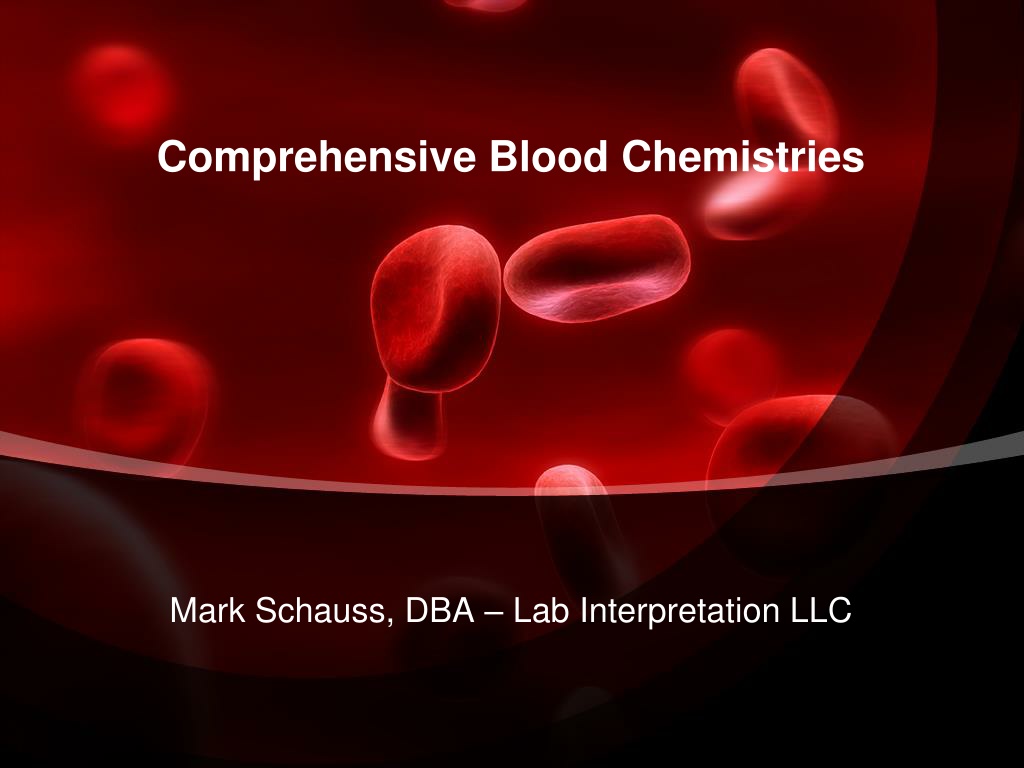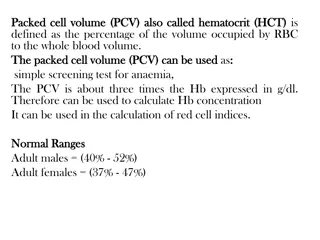Understanding Comprehensive Blood Chemistries and Reference Ranges
Comprehensive blood chemistries provide detailed insights into various elements within the body, allowing for a deeper understanding of health conditions. Reference ranges play a crucial role in interpreting these results, highlighting the importance of considering individual factors in analysis. By exploring the significance of different parameters and utilizing innovative approaches like the Status Deviation equation, healthcare practitioners can enhance their assessment and monitoring of patients' well-being.
Download Presentation

Please find below an Image/Link to download the presentation.
The content on the website is provided AS IS for your information and personal use only. It may not be sold, licensed, or shared on other websites without obtaining consent from the author. Download presentation by click this link. If you encounter any issues during the download, it is possible that the publisher has removed the file from their server.
E N D
Presentation Transcript
Comprehensive Blood Chemistries Mark Schauss, DBA Lab Interpretation LLC
Comprehensive Blood Chemistry In the U.S. and Australia alone there are over 150 million blood chemistries performed every year. Of that only 1-2% are what could be considered comprehensive. Most blood chemistries are run to look at a specific array of analytes depending on the condition the health care practitioner is concerned with. This often times leads to missing co-morbidities. The amount of information that can be culled from a correctly ordered blood chemistry is enormous.
Comprehensive Blood Chemistry Today s goal is to go over each element within each test we will be working with. We will start with the comprehensive blood chemistry and continue on with amino acids, organic acids, fatty acids, toxicity testing and heavy metals and trace mineral.
Reference Ranges Most of the reference ranges we use are based on population studies unless they are functionally incorrect. One example is TSH. The standard at most labs is .5-5.5 mIU/L. What we use is 1.2-2.5 because it is estimated that 35% of all people tested are hypothyroid and are included in the population studies. Another is magnesium. 68% of Americans and Australians consume less that the RDA and 19% consume less than of the RDA.
Reference Ranges The absurdity of a population based reference range for magnesium is because the range is based on 5% of the people being abnormal. The numbers just don t match up. Another aspect of what I do different than anyone else stems from a mathematical equation I came up with in 1985. It is commonly called the Status Deviation Basically it allows you to compare results from tests that have vastly different reference ranges and standards of measurement.
Reference Ranges What the equation does is the following If the range for sodium is 135-145 mEq/L Then the mid-point would be 140 and the Status Deviation would be 0% If the result was 135, the SD would be -50% If the result was 145, the SD would be +50% So each standard deviation away from the mid-point would be 50% either negative or positive. This allows us to compare progress better than any other system available and is the core of the Health Director Bio- Clarity Report which comes with many of the tests we will be discussing the next few days.
Comprehensive Blood Chemistry Glucose Reference Range 65-99 mg/dl Glucose, formed by the digestion of carbohydrates and the conversion of glycogen by the liver, is the primary source of energy for most cells. Insulin, glucagon, thyroid hormone, liver enzymes, and adrenal hormones regulate it. Low levels may be indicative of liver disease, overproduction of insulin, hypothyroidism, or alcoholism. It is elevated in diabetes, liver disease, obesity, pancreatitis, steroids, stress, or diet. International 3.6-5.5 mmol/L
Comprehensive Blood Chemistry Blood Urea Nitrogen (BUN) Reference Range 5-26 mg/dl Blood Urea Nitrogen is the byproduct of the breakdown of proteins. Low levels may be indicative of low levels of food intake which may lead to the body breaking down muscle tissue and thereby causing weakness. Severe liver insufficiency. Overhydration, especially decreased protein intake. Increased levels may be indiciative of impaired renal function, congestive heart failure, shock, gastrointestinal bleeding, a high- protein diet, or certain drug use (e.g., corticosteroids, tetracycline). International 1.8-9.3 mmol/L
Comprehensive Blood Chemistry Creatinine Reference Range .6-1.5mg/dL Creatinine is the waste product of muscle metabolism. Its level is a reflection of the body's muscle mass. Low levels are sometimes seen in kidney damage, protein starvation, liver disease, or pregnancy. Elevated levels are sometimes seen in kidney disease, muscle degeneration, or some drugs involved in impairment of kidney function. International 50-130 mol/L
Comprehensive Blood Chemistry Bilirubin, Total Reference Range .1-1.2 mg/dL Bilirubin is produced by the body from the breakdown of the hemoglobin found in red blood cells and muscle tissue. Low levels are not typically indicative of any condition. Extremely low levels are very rare. Uric Acid Reference Range 2.4-8.2 mg/dL Uric acid is the end product of purine metabolism and is normally excreted in the urine. Low levels may be indicative of kidney disease, malabsorption, poor diet, liver damage, or an overly acid kidney. High levels are noted in gout, infections, kidney disease, alcoholism, high protein diets, and with toxemia in pregnancy. International 1.7-20.5 mol/L International 140-450 mol/L
Comprehensive Blood Chemistry Iron, Total Reference Range 35-150 g/dL Iron is necessary for the formation of some proteins, hemoglobin, myoglobin, and cytochrome. Also, it is necessary for oxygen transport, cellular respiration and peroxide deactivation. Low levels are seen in many anemias, copper deficiencies, low vitamin C intake, liver disease, chronic infections, high calcium intake, and women with heavy menstrual flows. High levels are seen in hemochromatosis, liver damage, pernicious anemia, and hemolytic anemia. International 6.25-27 mol/L
Comprehensive Blood Chemistry Alkaline Phosphatase Reference Range 25-125 units/L International same Produced in the cells of bone and the liver with some activity in the kidney, intestine, and placenta. Decreased levels are sometimes found in hypoadrenia, protein deficiency, malnutrition, and a number of vitamin and mineral deficiencies. Increased levels are seen extensively as a tumor marker, in bone injury, pregnancy, or skeletal growth (elevated readings). Children typically have much higher levels than adults due to being in growth phases.
Comprehensive Blood Chemistry Protein Reference Range 6-8.5 g/dL Proteins are the most abundant compounds in serum. The protein makeup of the individual is of important diagnostic significance because of proteins involvement in enzymes, hormones and antibodies as well as osmotic pressure balance, maintaining acid- base balance, and as a reserve source of nutrition for the bodies tissues and muscles. The major serum proteins are Albumin and Globulin (alpha1, alpha2, beta and gamma). Decreased levels may be due to poor nutrition, liver disease, malabsorption, diarrhea, or severe burns. Increased levels are seen in lupus, liver disease, chronic infections, alcoholism, leukemia, and tuberculosis amongst many others. International 60-85 g/L
Comprehensive Blood Chemistry Albumin Reference Range 3.5-5.5 g/dL Albumin is the major constituent of serum protein (usually over 50%). It is manufactured by the liver from the amino acids taken through the diet. It helps in osmotic pressure regulation, nutrient transport, and waste removal. Lower levels are seen in poor diets, diarrhea, fever, infection, liver disease, inadequate iron intake, third-degree burns, edemas, or hypocalcemia (low calcium). High levels are seen in liver disease, shock, dehydration, or multiple myeloma. International 35-55 g/L
Comprehensive Blood Chemistry Globulin Reference Range 1.9-3.5 g/dL Globulin, a larger protein than albumin, is important for its immunologic responses, especially its gamma portion (IgA, IGG, IgM, and IgE). Globulins have many diverse functions such as, the carrier of some hormones, lipids, metals, and antibodies. Lower levels may be found in immune compromised patients, poor dietary habits, malabsorption, and liver or kidney disease. When chronic infections, liver disease, rheumatoid arthritis, myelomas, and lupus are present, elevated levels are seen. International 19-35 g/L
Comprehensive Blood Chemistry GGT Gamma Glutamyltransferase Reference Range 5-50 U/L GGT is believed to be involved in the transport of amino acids and peptides into cells as well as glutathione metabolism. GGT is mainly found in liver cells and, as such, is extremely sensitive to alcohol use. Decreased levels can be found in hypothyroidism, hypothalamic malfunction, and low levels of magnesium. Elevated levels may be found in liver disease, alcoholism, bile-duct obstruction, cholangitis, drug abuse, and in some cases excessive magnesium ingestion. International same
Comprehensive Blood Chemistry sGOT AST Aspartate Aminotransferase Reference Range 5-40 U/L International Same An enzyme found primarily in the liver, heart, kidney, pancreas, and muscles. Decreased levels can be found in Vitamin B deficiency and pregnancy. Elevated in tissue damage, especially heart and liver. sGPT ALT Alanine Aminotransferase Reference Range 5-40 U/L International Same An enzyme found primarily in the liver but also in the heart and other tissues. It is more useful in diagnosing liver function than sGOT levels are. Decreased sGPT in combination with increased cholesterol levels is seen in congested liver cases. Increased levels are seen in mononucleosis, alcoholism, liver damage, kidney infection, chemical pollutants, or myocardial infarction.
Comprehensive Blood Chemistry Sodium Reference Range 135-145 mEq/L Sodium is the most abundant cation in the blood and its chief base. It functions in the body to maintain osmotic pressure, acid-base balance and to transmit nerve impulses. Decreased levels are seen in severe burns, congestive heart failure, excessive fluid loss, Addison's disease, severe nephritis, pyloric obstruction, malabsorption, diabetic acidosis, diuretics, edema, and hypothyroidism. Increased levels are associated with dehydration, Conn's syndrome, primary aldosteronism, coma, Cushing's disease, diabetes insipidus, and tracheobronchitis. International same
Comprehensive Blood Chemistry Potassium Reference Range 3.5-5.5 mEq/L Potassium deficiencies may impair nerve and muscle function as well as lead to heart arythmiaas, hypertension, and depression. Deficiencies are commonly found in people with poor dietary habits especially those with high refined carbohydrate levels. Elevated T-wave heart block, flattened P wave. Cardiac arrest may occur without any warning other than ECG changes. Renal glomerular disease. Adrenocortical insufficiency. Diabetic ketoacidosis. Excessive intravenous potassium therapy. Sepsis. Panhypopituitarism. In vitro hemolysis. Observe for neuromuscular changes. International same
Comprehensive Blood Chemistry CO2 Bicarbonate Reference Range 20-32 mEq/L Bicarbonates are one of the main electrolytes in the blood stream along with sodium, potassium, and chlorides. Low readings are found in primary metabolic acidosis, as from diabetic ketoacidosis, uremia, starvation, lactic acidosis, alcoholic ketosis, salicylate ingestion. Primary respiratory alkalosis, as from CNS stimulation, salicylate ingestion, psychogenics hyperventilation, arterial hypoxemia. High results are found in primary metabolic alkalosis, as from vomiting, gastric suction, diuretic therapy, hypokalemia. Primary respiratory acidosis, as from chronic pulmonary disease, airway obstruction, respiratory center depression, pulmonary emphysema. International same
Comprehensive Blood Chemistry Chloride Reference Range 96-109 mEq/L International same Chloride's significance relates to its maintenance of cellular integrity through its influence on osmotic pressure. It also helps monitor acid- base balance and water balance. Decreased levels with decreased serum albumin may indicate water deficiency (edema) or overhydration with normal to elevated albumin Elevated levels are related to acidosis as well as excessive water crossing the cell membrane which is often found in dehydration states.
Comprehensive Blood Chemistry Calcium Reference Range 8.5-10.8 mg/dL International 2.12-2.7 mmol/L Calcium is an important mineral used by the body to build bone, control the cardiac muscle as well as cellular membrane health and blood clotting. Low levels may be indicative of hypoparathyroidism, hypoalbuminemia, chronic renal disease, acutepancreatits, vitamin D deficiency (rickets, osteomalacia), and malnutrition. High levels may be due to hyperparathyroidism, sarcoidosis, thiazide therapy, and thyrotoxicosis.
Comprehensive Blood Chemistry Phosphorus Reference Range 2.5-4.5 mg/dL International .97-1.45 mmol/L Phosphorus is another important mineral found in the body mostly associated with calcium but also to a lesser extent to magnesium. Low results may be due to hyperparathyroidism (primary), vitamin D deficiency, malabsorption, administration of glucose (hyperalimentation), hyperinsulinism, loss of phosphate in urine as in Fanconi's syndrome, insulin treatment of diabetic ketoacidosis, rickets and Sprue steatorrhea. Renal insufficiency, hypoparathyroidism and childhood may cause elevated serum phosphorus as well as excess vitamin D intake or a high calcium diet. Often times phosphorus excess is inversely related to calcium. Excessive cola intake (phosphoric acid) may also increase serum phosphorus levels.
Comprehensive Blood Chemistry Cholesterol Reference Range 140-240 mg/dL International 3.6-6.2 mmol/L Cholesterol is a fat found in the blood that has been discussed as a risk factor, when low, for depression and stroke, when elevated, to an increased risk of cardiovascular disease. Low levels may be caused by liver insufficiency, malnutrition, hyperthyroidism, chronic anemia, Waldenstrom's macroglobulinemia, and thyroiditis. High levels may be caused by familial (hereditary) hypercholesterolemia, biliary obstruction, nephrotic syndrome, hypothyroidism, and pregnancy.
Comprehensive Blood Chemistry LDL Low Density Lipoprotein Reference Range 62-130 mg/dL LDL is the cholesterol rich remnants of the lipid transport vehicle VLDL (very-low density lipoproteins). There have been many studies showing correlations between high levels of LDL and arterial artherosclerosis. Due to the expense of direct LDL measurement, a calculation known as the Friedewald formula is used (Total Cholesterol - HDL Cholesterol - Triglycerides/5). When Triglyceride levels are greater than 400, this method is not accurate. Decreased levels are associated with Tangier disease, Apo-C-II deficiency, hyperthyroidism, chronic anemias, hepatocellular disease, Reye's syndrome, acute stress, inflammatory joint disease, and chronic pulmonary disease. Increased levels are seen in high cholesterol diets, nephrotic syndromes, multiple myeloma, hepatic obstruction or disease, anorexia nervosa, diabetes, chronic renal failure, and premature coronary heart disease. International 1.6-3.3
Comprehensive Blood Chemistry HDL High Density Lipoprotein Reference Range 35-85 mg/dL HDL cholesterol is also known as the good cholesterol as it helps to remove excess cholesterol from the tissues. According to the Framingham Heart Study, individuals with high levels of HDL were at lower risk of CVD than those with lower levels. Important ratios include HDL/Cholesterol 0.24 or higher is considered ideal under 0.24 - low less than 0.10 - very dangerous International .9-2.2
Comprehensive Blood Chemistry Triglycerides Reference Range 25-150mg/dL Triglycerides is where most of the stored fat in the body resides. Low triglycerides may be indicative of low levels of essential fatty acids. While high triglycerides are clearly associated with coronary heart disease, it is also been shown to be responsive to dietary changes. Elevated triglycerides are far more destructive than elevated cholesterol levels and should be aggressively dealt with. International .28-1.7
Comprehensive Blood Chemistry LDH Lactic Dehydrogenase Reference Range 100-240 U/L Lactic acid dehydrogenase is an intracellular enzyme found primarily in the kidney, heart, skeletal muscle, brain, liver, and lungs. Decreased levels of the enzyme may be seen in cases of malnutrition, hypoglycemia, adrenal exhaustion, or low tissue or organ activity. Increases are usually found in cellular death and/or leakage from the cell. In some cases it can be useful in confirming myocardial or pulmonary infarction (only in relation to other tests). International same
Comprehensive Blood Chemistry TSH Thyroid Stimulating Hormone Reference Range 1.1-2.5 mIU/L TSH, produced by the anterior pituitary gland, causes the release and distribution of stored thyroid hormones. When T4 and T3 are too high, TSH secretion decreases. When T4 and T3 are low, TSH secretion increases. Decreased levels of TSH are seen in hyperthyroidism and secondary and tertiary hypothyroidism. Increased TSH levels are seen in primary hypothyroidism, thyrotropin producing tumors, and thyrotoxicosis. International same
Comprehensive Blood Chemistry T4 Thyroxine Reference Range 4-12 g/dL Thyroxine is the thyroid hormone that contains four atoms of iodine. It is used to evaluate thyroid function. It is the direct measurement of total T4 concentration in the blood serum. Low levels can be found in hypothyroidism, cirrhosis, malnutrition, and chronic thyroiditis. Increased levels are found in hyperthyroidism, acute thyroiditis, and hepatitis. International 50-150 nmol/L
Comprehensive Blood Chemistry Free T4 Reference Range .8-1.8 g/dL Although free thyroxine is only a small fraction of total thyroxine it is the metabolically active form of this hormone. Low free T-4 may be indicative of hypothyroidism or a disregulation of the production of T-3. It could also indicate a lack of iodine. An elevated result is commonly associated with Graves disease or thyrotoxicosis. International 10-23 nmol/
Comprehensive Blood Chemistry Free T-3/Free Triiodothyronine Reference Range 230-420 pg/dL International 3.5-6.5 pmol/L Existing in its free state (unbound to protein) free triiodothyronine measurements are helpful in determining thyroid function. Low readings are found in hypothyroidism and the third trimester of pregnancy. High readings are commonly found in hyperthyroidism, T3 toxicosis and peripheral resistance syndrome.
Comprehensive Blood Chemistry Hematology RBC Red Blood Cell count Reference Range Female 3.8-5.1 Male 4.2-5.8 The red blood cell's main function is to carry oxygen to the tissues and to transfer carbon dioxide to the lungs. This process is possible because red blood cells contain hemoglobin, which combines easily with oxygen and carbon dioxide. Low results may be due to anemia, blood loss, dietary insufficiency, or lupus. High results may be due to dehydration or diarrhea.
Comprehensive Blood Chemistry - Hematology HGB Hemoglobin Reference Range Female 11.7-15.5 g/dL Male 13.2-17.1 g/dL Hemoglobin is the main transport of oxygen and carbon dioxide in the blood. It is composed of globin a group of amino acids that form a protein and heme which contains iron atoms and the red pigment, porphyrin. As with Hematocrit, it is an important determinant of anemia (decreased), dehydration (increased), polycythemia (increased), poor diet/nutrition, or possibly a malabsorption problem. International 117-155 g/L International 132-171 g/L
Comprehensive Blood Chemistry - Hematology HCT Hematocrit Reference Range Female 35-45% Male 38-50% Hematocrit is the percentage of red blood cells in whole blood. It is an important determinant of anemia (decreased), polycythemia (elevated), dehydration (elevated), increased R.B.C. breakdown in the spleen (elevated), or possible overhydration (elevated). The word hematocrit means, "to separate blood," a procedure that is followed after blood collection through the proper use of a centrifuge. International .35-.45 proportion of 1 International .38-.45 proportion of 1
Comprehensive Blood Chemistry - Hematology MCV Mean Corpuscular Value Reference Range 80-95 mmInternational same The Mean Corpuscular Volume reflects the size of red blood cells by expressing the volume occupied by a single red blood cell. Decreased readings may indicate microcytic anemia, possibly caused by iron deficiency. Increased readings may indicate macrocytic anemia, B6, B12 or Folic Acid deficiency, or excessive alcohol intake. MCH Mean Corpuscular Hemoglobin Reference Range 27-31 pg Mean Corpuscular Hemoglobin (MCH) gives the average weight of hemoglobin in the red blood cell. Decreased MCH is associated with microcytic anemia. Increased MCH is associated with macrocytic anemia.
Comprehensive Blood Chemistry Hematology MCHC Mean Corpuscular Hemoglobin Concentration Reference Range 32-36 g/dL or % This test measures the average concentration of hemoglobin in red blood cells. It is most valuable in evaluating therapy for anemia because Hemoglobin and Hematocrit instead of R.B.C. are used in the calculation. Low MCHC means that a unit of packed R.B.C.'s contain less hemoglobin than normal and a high MCHC means that there is more hemoglobin in a unit of R.B.C.'s. Decreased levels may indicate iron deficiency, blood loss, or B6 deficiency. Increased MCHC is seen in spherocytosis, and not seen in pernicious anemia.
Comprehensive Blood Chemistry Hematology WBC White Blood Cell Count Reference Range 4-10 x 1000 The white blood cells' main function is to fight infection, defend the body by phagocytosis against invasion by foreign organisms, and to produce, or at least transport and distribute, antibodies in the immune response. Each type of cell, or leukocyte, has a different job in the body, which is explained in the Differential section. Decreased levels of white blood cells, leukopenia, may occur during certain viral infections, hypersplenism, drugs, primary bone disorders, fungal infections, metastatic tumors, and iron deficiency anemia. An increase in all types of white blood cells simultaneously is rarely seen.
Comprehensive Blood Chemistry Neutrophils Reference Range 55-70% Also known as Granulocytes or poly-segmented neutrophils, this is the main defender of the body against infection and antigens. A low count may indicate a compromised immune system or depressed bone marrow (low neutrophil production). High levels may indicate an active infection. Lymphocytes Reference Range 20-40% Lymphocytes are involved in protection of the body from viral infections such as measles, rubella, chickenpox, or infectious mononucleosis. Elevated levels may indicate an active viral infection or lymphocytic leukemia.
Comprehensive Blood Chemistry Monocytes Reference Range 2-10% These white blood cells are helpful in fighting severe infections, are considered the body's second line of defense against infection and are the largest cells in the blood stream. Low levels may be indicative of a state of good health. Elevated levels are seen in tissue breakdown, chronic infections, carcinomas, leukemia (monocytic) and lymphomas.
Comprehensive Blood Chemistry Eosinophils Reference Range 1-8% Eosinophils protect the body from parasites and allergic reactions. Low levels may be indicative of adrenal insufficiency, bacterial infection with high neutrophils, or secretion of epinephrine. Elevated levels may indicate an allergic response. Basophils Reference Range 0-2% Basophil cells are a type of white blood cell linked to allergic reactions. Recently they were found to possibly help guide the immune systems responses. Elevated levels along with high eosinophils are excellent indicators of allergies and should be further investigated.
Comprehensive Blood Chemistry Other tests available Hemoglobin A1c - Hb1Ac Helpful in assessing blood sugar control C-Reactive Protein CRP Important in measuring levels of inflammation Prostate Specific Antigen (PSA)/Free PSA PSA alone is a non-specific, non-predictive measurement of prostate cancer. Free PSA, when done in conjunction is a much better tool in assessing the potential for the development of prostate cancer. Please only order this test for men.
Comprehensive Blood Chemistry Fibrinogen This is an important measurement of the blood clotting, coagulation system. High levels are often seen in an increased risk of coronary heart disease, stroke and myocardial infarction Growth Hormone Helpful in screening for pituitary hypofunction, growth deficiencies, delayed sexual maturity and in adolescents with short stature. Vitamim B12 and Folic Acid Not a preferred measurement of functional B12 and Folic Acid sufficiency. Way too often it is over relied upon and is not indicative of true deficiency unless very low.
Comprehensive Blood Chemistry Vitamin D There are two vitamin D tests -- 1,25(OH)D and 25(OH)D. 25(OH)D is the better marker of overall D status. It is this marker that is most strongly associated with overall health Do not test for vitamin D2 as it is inactive and a very poor marker for general vitamin D sufficiency. Reference Range 30-120 ng/ml Optimal level is around 70-80 ng/ml or 175-200 nmol/L International 75-300 nmol/L























